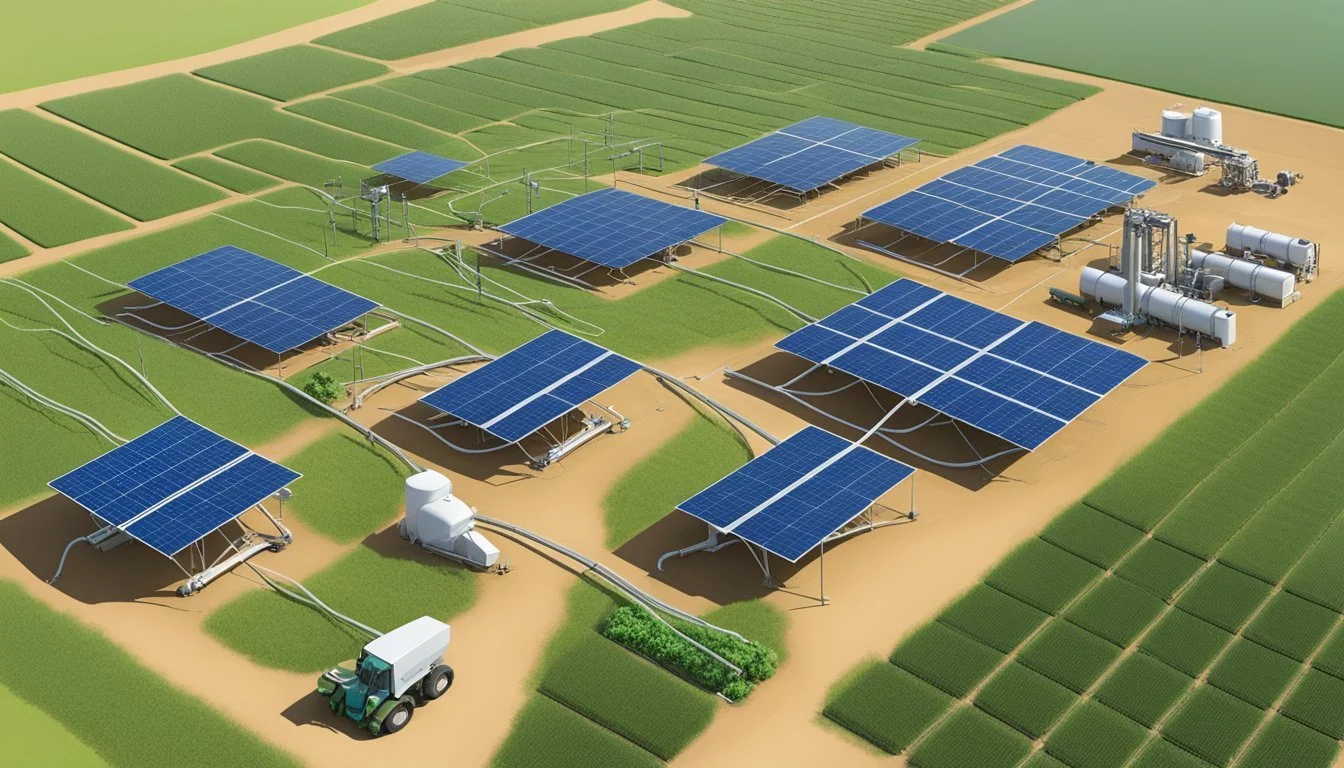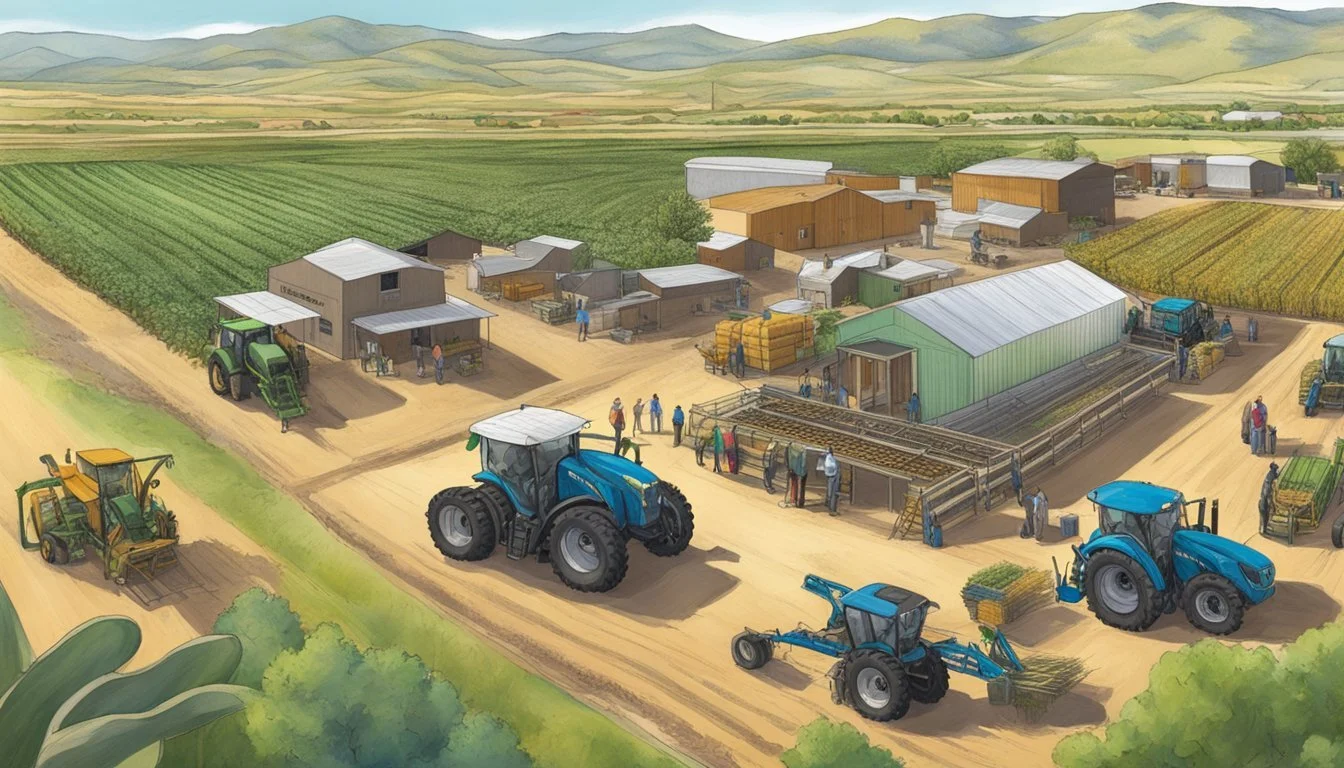Farming Communities in New Mexico
Building Sustainable Futures
Farming communities in New Mexico form a vital backbone of the state's economy and environmental sustainability. Agriculture significantly supports New Mexico's financial stability, providing numerous jobs and fostering local economies. These communities are not only crucial for their economic contributions but also for their commitment to preserving the land and resources.
These agricultural hubs are scattered throughout the state, from the sun-soaked fields of southern New Mexico to the high-altitude pastures near Santa Fe. The dedication of New Mexican farmers and ranchers to sustainable farming practices ensures the longevity and health of these vital lands. Their efforts play an essential role in maintaining the balance between agricultural productivity and environmental conservation.
Community spirit is another hallmark of farming life in New Mexico. The mutual support among farmers, ranchers, and local businesses nurtures a sense of unity and shared purpose. The state's rich traditions in farming and ranching weave a unique tapestry of cultural heritage and rural resilience, which continues to thrive amid modern challenges.
Historical Context of New Mexico Farming Communities
New Mexico's farming communities have a long and diverse history shaped by early agricultural practices and the influence of different cultural traditions.
Early Agricultural Practices
Farming in New Mexico dates back at least 2,500 years. The Mogollon and Pueblo peoples were among the earliest known farmers, cultivating staples like corn, beans, and squash. These crops were central to their diet and lifestyle.
The Puebloans, including communities in Taos and Laguna, developed complex irrigation systems to sustain their crops in an arid environment. These systems often included acequias, communal irrigation channels that are still in use today.
With European colonization, new crops such as wheat and barley were introduced. Settlers also brought livestock, which significantly changed the agricultural landscape.
Influence of Cultural Traditions
Cultural traditions have deeply influenced farming practices in New Mexico. Native American techniques, combined with those brought by Spanish settlers, created a unique agricultural blend. The introduction of items like chiles and indigo from Mexico further diversified farming practices.
Language also played a vital role in farming communities. Agricultural terms and knowledge were passed down through generations in native languages and Spanish. This multilingual heritage is still evident in New Mexico's modern farming communities.
Festivals and traditional farming methods continue to be celebrated, keeping the agricultural heritage alive. The blend of native and colonial influences is seen in crop choices, farming techniques, and community practices.
Environmental Considerations and Challenges
Farming communities in New Mexico face significant environmental challenges that impact their productivity and sustainability. These challenges include climate change, water resource management, and soil conservation techniques.
Climate Change and Its Impacts
Climate change has led to rising temperatures, altered precipitation patterns, and more extreme weather events in New Mexico. Higher temperatures increase evapotranspiration, making it more difficult for crops to retain moisture. Drought conditions have become more frequent and severe, reducing water availability for irrigation and stressing ecosystems.
Extreme wildfires, fueled by prolonged dry conditions, decimate forests and rangelands, further exacerbating the challenges for farmers. These changes disrupt planting schedules and reduce yields, creating an uncertain future for the agricultural sector.
Water Resource Management
Water is a crucial resource for New Mexico's farming communities, making effective management essential. Drought and diminished snowfall levels have led to a decline in surface and groundwater supplies. Competing needs between agriculture, municipalities, and environmental conservation further strain these limited resources.
Farmers are increasingly adopting advanced irrigation techniques such as drip irrigation and scheduling tools to optimize water use. Restoration projects aim to enhance natural water recharge systems, while policies and programs promote efficient water allocation and sharing among users to sustain farming and ecosystems.
Soil Conservation Techniques
Maintaining healthy soil is vital for sustainable agriculture in New Mexico. Soil erosion, nutrient depletion, and contamination pose significant threats. Implementing soil conservation techniques helps mitigate these issues, ensuring long-term productivity.
Cover cropping, no-till farming, and integrating organic matter are strategies employed to enhance soil health. These practices improve water retention, reduce erosion, and increase biodiversity within farming ecosystems. Furthermore, initiatives like the NM Healthy Soil Working Group focus on educating farmers about best practices in soil conservation, aiming to balance agricultural needs with environmental stewardship.
Economic Aspects of New Mexico Agriculture
New Mexico's agriculture significantly impacts both the local and regional economy, with a variety of revenue streams reflecting the state's diverse farming practices. Despite this economic wealth, many farming communities face economic challenges such as poverty, which adds complexity to the agricultural landscape.
Contribution to Local and Regional Economy
The 2023 Feeding the Economy report highlights that New Mexico's food and agriculture industry has an economic impact of $40.23 billion. Studies indicate continued growth, with the 2024 report estimating an impact of $43.12 billion. Agriculture supports thousands of jobs, primarily through family-operated farms and ranches.
The production of crops, livestock, and dairy, particularly cattle and milk products, forms the bedrock of the state's agricultural sector. This industry ties closely with other local businesses, fostering economic growth throughout New Mexico communities.
Revenue Streams and Farm Size
Agricultural revenue in New Mexico arises from various sources. Major commodities include cattle and calves, which in 2022 generated $1.15 billion in production value. Revenue also stems from crops like grapes used in the wine industry, contributing approximately $876 million to the economy.
Farm size varies significantly across the state. According to the New Mexico Department of Agriculture, there were 24,721 farm and ranch operations in 2012. Nearly 62.1% of these are considered small by USDA standards, with annual sales less than $250,000. This diversity in farm size reflects economic stratification within the agricultural community.
Poverty and Economic Diversity
Despite the substantial economic contribution from agriculture, many farming communities in New Mexico confront ongoing poverty. Factors contributing to this include limited access to resources and market fluctuations impacting small-scale farmers disproportionately.
Economic diversity within these communities includes various income sources like direct government payments and non-agricultural employment. These additional income streams are essential for mitigating the effects of agricultural uncertainties and sustaining local economies.
Programs aimed at economic development and poverty alleviation play a critical role. Identifying and addressing rural poverty remains a priority to ensure these communities thrive in tandem with the agricultural sector's growth.
Social Dynamics within Farming Communities
Farming communities in New Mexico exhibit unique social dynamics that support community-centric agriculture, emphasize education through schools, and address health concerns related to farming practices. These factors work together to sustain the community’s growth and resilience.
Community-Driven Agriculture
Community-driven agriculture in New Mexico is fundamental for economic and social cohesion. Many families participate in community-supported agriculture (CSA) programs where locals invest in farms at the start of the growing season and receive a share of the produce.
This method fosters strong relationships between farmers and community members, ensuring economic stability and shared benefits. Additionally, community projects often focus on sustainable practices, drawing inspiration from indigenous methodologies.
By involving community members in agricultural activities, a shared sense of purpose and mutual support is cultivated, enhancing the overall resilience of these rural areas.
The Role of Schools and Education
Schools in farming communities play a critical role in promoting agricultural literacy and sustainability. They often incorporate agricultural education into the curriculum, teaching students the importance of local food systems and sustainable farming techniques.
Programs encouraging youth to pursue careers in agriculture ensure the continuity of these practices. Schools also serve as venues for workshops and community events, strengthening the bond between education and practical farming.
Educational initiatives often extend beyond the classroom, with students participating in garden projects and community farms, directly engaging with the environment they study.
Health Concerns Related to Farming
Health issues such as diabetes are prevalent among farming communities, partly due to physical demands and dietary habits. Farmers face unique occupational hazards, including exposure to pesticides and long working hours, which can impact their health.
Community health programs aim to address these concerns by promoting healthy lifestyle choices and providing access to healthcare services. Initiatives often include nutritional guidance, emphasizing the benefits of consuming fresh, locally-grown produce.
Efforts to create awareness about health risks and preventative measures are integral in maintaining the well-being of individuals within these communities, ensuring that farming remains a sustainable livelihood for future generations.
Sustainable Agriculture and Future Outlook
New Mexico is working hard to adopt sustainable agricultural practices that boost local food systems and protect public lands. Innovative approaches and a focus on organic farming play a crucial role in ensuring the state's agricultural future is both productive and environmentally-friendly.
Implementation of Sustainable Practices
Sustainable practices in New Mexico include crop rotation, cover cropping, and reduced tillage. Farmers use these methods to improve soil health and increase biodiversity. They help reduce erosion and enhance the soil's ability to retain water, crucial in a state with limited rainfall.
Composting and the use of organic fertilizers contribute to nutrient-rich soil without relying on synthetic chemicals.
Efforts are also being made to integrate solar energy and efficient irrigation systems, ensuring resource conservation and reduced operational costs.
Organic Farming and Local Food Systems
Growing interest in organic farming is transforming New Mexico's agricultural landscape. Organic farms avoid synthetic pesticides and fertilizers, focusing on natural alternatives to manage pests and enhance soil fertility. This method not only aligns with sustainability goals but also caters to the rising consumer demand for healthy, locally-sourced food.
Local food systems are supported by farmers' markets and community-supported agriculture (CSA) programs, which connect consumers directly with producers. This helps reduce the carbon footprint associated with food transportation and promotes economic viability for local farmers.
Public Lands and Conservation
Public lands play a significant role in New Mexico's agriculture. Conservation efforts on these lands aim to preserve natural resources and biodiversity. Rotational grazing and habitat restoration projects are integral to maintaining the ecological balance.
Initiatives such as the NM Healthy Soil Working Group bring together various stakeholders to advance these goals. Protecting these resources ensures that future generations can continue to benefit from the land's bounty, safeguarding the environment and supporting sustainable agriculture.
Agricultural Production and Crop Diversity
New Mexico's farming communities cultivate a wide range of crops and livestock, employing sustainable practices and adapting to market trends. The state is known for its unique crops and significant contributions to organic agriculture.
Main Crops and Livestock
New Mexico is notable for its diverse crop production. Chile peppers are a signature crop, representing 33% of U.S. production. Additionally, the state produces substantial quantities of onions and pecans.
Livestock also plays a crucial role, particularly in dairy farming. New Mexico's dairy farms are among the top in milk production nationwide. Farmers also raise beef cattle, contributing to the state's economy.
Diversified farming ensures that communities can adapt to market demands and environmental changes.
Crop Rotation and Use of Natural Materials
Farmers in New Mexico often employ crop rotation to maintain soil health and reduce pest infestations. For instance, rotating corn with cover crops like legumes helps replenish nitrogen in the soil. This practice minimizes the need for synthetic fertilizers.
The use of natural materials such as compost and manure further enhances soil quality. Farmers also grow hay as a rotational crop, which helps in disrupting pest cycles and improving soil structure. Utilizing these materials supports sustainable farming practices.
Organic Production and Market Trends
Organic farming has seen significant growth. New Mexico has a strong market for organic vegetables, with beans and corn being popular. The state's climate allows for the production of high-quality organic crops.
Farmers often sell directly to consumers through local markets and retail outlets. This method boosts farm incomes and meets the demand for organic produce. Additionally, the increase in organic farming practices demonstrates a commitment to environmental sustainability and health-conscious consumers.
By focusing on these methods, New Mexico's agricultural communities continue to thrive, ensuring long-term productivity and market relevance.
Infrastructure, Technology, and Innovation
New Mexico's farming communities are experiencing significant growth through advancements in technology, improved infrastructure, and comprehensive financial support and marketing strategies. These developments are reshaping the agricultural landscape.
Advancements in Farming Technology
New Mexico's agricultural sector is incorporating cutting-edge technologies to enhance productivity and sustainability. Precision agriculture tools, such as GPS-guided tractors and drones, enable farmers to optimize planting, watering, and harvesting processes. Automated irrigation systems help combat the region's drought challenges by conserving water and ensuring efficient usage.
In addition, biotechnology innovations such as drought-resistant crop varieties are being introduced. These advancements aim to bolster crop yields and resilience against extreme weather conditions. A focus on sustainable practices ensures that technology integration benefits both the economy and the environment.
Infrastructure for Distribution and Access
Infrastructure development is crucial for connecting farmers with markets. Improved road networks and transport facilities allow for efficient distribution of agricultural products. The enhancement of cold storage and packaging facilities ensures that produce remains fresh during transit, expanding the reach to distant markets.
Investments in digital infrastructure facilitate better communication and data management. Online platforms provide farmers with real-time market prices, weather updates, and logistical support. These improvements are essential for addressing the supply chain gaps exposed by recent challenges, ensuring food accessibility and security.
Financial Support and Marketing Strategies
Financial support mechanisms are pivotal in enabling farmers to adopt new technologies and improve infrastructure. Government programs and grants offer funding for farm modernization projects. Local banks and credit unions provide loans with favorable terms, reducing the financial burden on farmers.
Marketing strategies help farmers reach broader audiences. Initiatives such as farmers’ markets and online marketplaces empower local producers to sell directly to consumers, enhancing profitability. Collaborative efforts between agricultural organizations promote New Mexico's unique products, attracting national and international buyers.
Effective marketing campaigns highlight the quality and sustainability of local produce, creating a strong brand identity for New Mexico agriculture.
Community and Food Networks
Farming communities in New Mexico are deeply intertwined with various food networks that bolster local and regional food systems and address issues of food security. These networks include community-driven initiatives, local markets, and strategic programs aimed at mitigating food insecurity.
Local and Regional Food Systems
New Mexico's local and regional food systems are comprised of community-supported agriculture (CSA) programs, local food hubs, and farmer cooperatives. Initiatives like the New Mexico Grown Coalition work with public institutions and local producers to enhance access to healthy, locally sourced food. In Las Cruces, numerous community-based organizations support farmers in improving production and distribution efficiencies. Such efforts help foster a sustainable food economy that is both prosperous and environmentally sound.
Food Security and Insecurity
Food security remains a significant focus within New Mexico's farming communities. Programs like the Regional Farm to Food Bank (RFFB) initiative play a critical role in providing underserved areas with fresh produce at fair prices. This program not only supports local farmers but also ensures that vulnerable populations have access to nutritious food. Despite these efforts, food insecurity persists in various regions, highlighting the need for continuous community-driven solutions and governmental support.
Food Retail and Aggregation
Food retail and aggregation systems are vital for connecting local farmers with consumers. Grocery stores, farmers' markets, and food hubs serve as crucial points of sale and distribution. Organizations like New Mexico Grown facilitate these connections, allowing farmers to reach broader markets. This system of aggregation not only supports local economies but also provides residents with consistent access to fresh, locally produced items. Efficient food aggregation initiatives ensure that both urban and rural communities benefit from the state's agricultural output.
Support and Development Initiatives
Farming communities in New Mexico receive substantial support and development initiatives tailored to enhance sustainability, economic growth, and community building. Emphasis is placed on grants, farmer collaboration, and trust-building.
Grants and Programs for Farmers and Ranchers
New Mexico’s rural farmers and ranchers benefit from various grant programs designed to boost economic growth and sustainable farming practices.
The USDA offers large grants, with some awards reaching up to $2 million, providing significant funding for rural development. These grants can target multiple areas including housing, community facilities, and economic development projects. The Rural Community Development Initiative is another notable program, offering grants to facilitate home-ownership and minority business entrepreneur education.
Local initiatives like the Rural Roots program specifically support youth agricultural organizations, protect NM agriculture, and fight hunger. They provide direct support to underserved populations and fund producer education within the state.
Collaboration with Small Farmers
Collaboration among small farmers and ranchers is essential for sustaining New Mexico's agriculture industry. Farmers work together to share knowledge, resources, and best practices.
Programs like Growing Rural Communities from Within highlight the importance of community-focused agricultural efforts. The New Mexico Economic Development Department (EDD) actively promotes investments in small farming communities, encouraging cooperative growth and shared benefits.
Such collaborations are not only crucial for the economic stability of these small farms but also for sustaining the cultural heritage of New Mexico’s agricultural practices. Small farmers often engage in joint-marketing strategies, cooperative purchasing of supplies, and collective problem-solving.
Building Trust and Relationships
Trust and relationship-building form the cornerstone of effective support and development initiatives.
Community engagement is fostered through transparent communication and active involvement of local stakeholders in decision-making processes. This is particularly emphasized in programs like the USDA’s, which involves webinars and informational sessions to educate and connect with rural farmers.
Building long-term trust also involves showing consistent support. Investments like the $86 million announced by the USDA for rural areas reflect a serious commitment to improving equitable access to jobs and business opportunities. By fostering trust through steady and reliable support, these initiatives ensure sustainable growth and development for New Mexico's farming communities.









